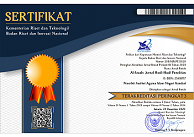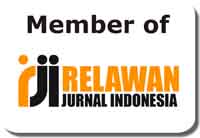Rediscovering ‘Sacred Place’ through the Indigenous Religion Paradigm: A Case Study of Bugis-Makassar Indigenous People
Abstract
The Bugis-Makassar indigenous people who live around Mount Bawakaraeng perform a ritual pilgrimage (hajj) to the top of Mount Bawakaraeng (as a sacred space). This ritual is often considered heretical and deviant. These negative assumptions are the result of the monopoly definition of “sacred place” by the world religion paradigm which is only limited to the doctrine of the holy book and is hierarchical-exclusive. Meanwhile, in the indigenous religion paradigm, “sacred place” is closely related tothe surrounding environment (nature) which also gives life to indigenous peoples. The Bugis-Makassar indigenous people who live around Mount Bawakaraeng construct the sacredness of the mountain, not only as a place for religious rituals but also as a guarantor of their life. There were lacking previous researches discussing “sacred place” through the indigenous religion paradigm approach. This research contributes to that lack. This study examines how the indigenous religion paradigm interprets “sacred place”. The research method used in this research is qualitative. This study argues that there is no better way to understand why indigenous people perform rituals on Mount Bawakaraeng than using the indigenous religion paradigm. This study also shows that the “sacred place” associated with Mount Bawakaraeng is a way for the indigenous people who live around the mountain to preserve the nature around them which has enabled them to live and make a living such as accessing water, gathering medicines from nature, and so on. Eventually, with research that provides a better explanation of what a “sacred place” is in the indigenous religion paradigm, negative assumptions about indigenous people who regard a mountain as sacredplace can be better understood.
Keywords
Full Text:
PDFReferences
Adhan, Syamsurijal, Musafir Pababari, Muhammad Ramli, and Wahyuddin Halim. “Aji Ugi: Pergumulan Islam Dengan Tradisi Lokal Dan Gaya Hidup Dalam Masyarakat Bugis.” Al-Qalam 26, no. 1 (2020): 19–38. doi:10.31969/alq.v26i1.846.
Alfian, Andi. “Evaluating World Religion Paradigm through the Idea of Ultimate Reality.” Jurnal Islam Transformatif: Journal of Islamic Studies 6, no. 1 (2022): 62–73. doi:http://dx.doi.org/10.30983/it.v6i1.5537.
———. “Symbolic Violence in Religious Discourse in Indonesia.” In International Conference on Social and Islamic Studies, 205–14. Proceedings of the International Conference on Social and Islamic Studies 2021, 2021.
Babbie, Earl. The Practice of Social Research. 14th ed. Vol. 22. Belmont: Cengage Learning, 2014.
Bagir, Zainal Abidin. “The Importance of Religion and Ecology in Indonesia.” Workdviews 19, no. 2 (2015): 99–102.
Bagir, Zainal Abidin, Asfinawati, Suhadi, and Renata Arianingtyas. “Limitations to Freedom of Religion or Belief in Indonesia: Norms and Practices.” Religion and Human Rights 15, no. 1–2 (2020): 39–56. doi:10.1163/18710328-BJA10003.
Bakht, Natasha, and Lynda Collins. “'The Earth Is Our Mother’: Freedom of Religion and the Preservation of Indigenous Sacred Sites in Canada.” McGill Law Journal - Revue de Droit de McGill, 2017, 777–812.
Banton, Michael, ed. Anthropological Approaches to the Study of Religion. Abingdon: Routledge, 2004.
Berkes, Fikret. Sacred Ecology. New York: Routledge, 2017.
Bryman, Alan. Social Research Methods. Oxford university press, 2015.
Cox, James L. From Primitive to Indigenous: The Academic Study of Indigenous Religions. Burlington, USA: Ashgate Publishing Company, 2007.
Durkheim, Emile. The Elementary Forms of Religious Life. The Free Press, 1995.
Eliade, Mircea. The Sacred and The Profane: The Nature of Religion. First. Harcourt Brace Jovanovich, 1987.
Fatem, Sepus M, San A.Awang, Satyawan Pudyatmoko, Muhammad A K Sahide, Andita A Pratama, and Ahmad Maryudi. “Camouflaging Economic Development Agendas with Forest Conservation Narratives: A Strategy of Lower Governments for Gaining Authority in the Re-Centralising Indonesia.” Land Use Policy 78, no. July (2018): 699–710. doi:10.1016/j.landusepol.2018.07.018.
Fisher, Micah R, Timothy Workmanc, Agus Mulyana, Balang Institute, Moira Moeliono, E Linda Yuliani, Carol J Pierce Colfer, and Urban El Fatih Bani Adam. “Striving for PAR Excellence in Land Use Planning: Multi-Stakeholder Collaboration on Customary Forest Recognition in Bulukumba, South Sulawesi.” Land Use Policy 99 (2020). doi:10.1016/j.landusepol.2017.09.057.
Galloway, Greta, Pat Wilkinson, and Gavin Bissell. “Empty Space or Sacred Place? Place and Belief in Social Work Training.” The Journal of Practice Teaching and Learning 8, no. 3 (2012): 28–47. doi:10.1921/jpts.v8i3.380.
Geertz, Clifford. The Interpretation of Cultures : Selected Essays. New York: Basic Books, Inc., Publishers, 1973.
Hak, I. “Prosesi Ritual Dan Komunitas ‘Haji Bawakaraeng’ Studi: Atas Kepercayaan Lokal Dalam Tinjauan Antropologi Agama.” Jurnal Al Adyaan; Jurnal Sosial Dan Agama 6, no. 1 (2019): 1–16.
Hakim, Fany Nur Rahmadiana. “Redefining ‘Sacred’ through the Indigenous Religion Paradigm: Case Study of Sunda Wiwitan Community in Kuningan.” Religio: Jurnal Studi Agama-Agama Vol. 12, no. No. 1 (2022): 42–63. doi:https://doi.org/10.15642/religio.v12i1.1859.
Idris, Syarifuddin. “Konstruksi Ritual Ibadah Haji Pada Masyarakat Sekitar Gunung Bawakaraeng Kab. Gowa.” Al-Qalam 23, no. 2 (2017): 237–48. doi:10.31969/alq.v23i2.427.
Islamy, Muh. Fajar, and Abd. Rahman R. “Ritualisme Ibadah Haji Bawakaraeng Persepsi Masyarakat Lembanna; Studi Kasus Lembanna.” Shautuna: Jurnal Ilmiah Mahasiswa Perbandingan Mazhab 2 (2021): 571–81.
Jubba, Hasse, Mustaqim Pabbajah, Zaenuddin H Prasodjo, and Zuli Qodir. “The Future Relations between the Majority and Minority Religious Groups, Viewed from Indonesian Contemporary Perspective: A Case Study of the Coexistence of Muslims and the Towani Tolotang in Amparita, South Sulawesi.” International Journal of Islamic Thought 16 (2019): 13–23. doi:10.24035/ijit.16.2019.002.
Keller, Mary L. “Indigenous Studies and ‘the Sacred.’” American Indian Quarterly 38, no. 1 (2014): 82–109. doi:10.5250/amerindiquar.38.1.0082.
Maarif, Samsul. “Ammatoan Indigenous Religion and Forest Conservation.” Worldviews 19, no. 2 (2015): 144–60. doi:10.1163/15685357-0190200.
———. “Dimensions of Religious Practice The Ammatoans of Sulawesi, Indonesia.” Oriens. Arizona State University, 2012. doi:10.2307/1578909.
———. “Indigenous Religion Paradigm: Re-Interpreting Religious Practices of Indigenous People.” Studies in Philosophy 44 (2019): 103–21. doi:http://doi.org/10.15068/00155157.
———. “Re-Establishing Human-Nature Relations: Responses of Indigenous People of Indonesia to Covid-19.” Interdisciplinary Journal for Religion and Transformation in Contemporary Society 7 (2021): 447–472.
Masuzawa, Tomoko. The Invention of World Religions. Method and Theory in the Study of Religion. Vol. 20. London: The University of Chicago Press, 2005.
Mattulada, Andi. “Elite Di Sulawesi Selatan.” Antropologi Indonesia 0, no. 48 (2014): 86–101. doi:10.7454/ai.v0i48.3281.
Nasr, Seyyed Hossein. The Encounter of Man and Nature. The Spiritual Crisis of Modern Man. Die Welt Des Islams. Vol. 12. George Allen & Unwin, 1968. doi:10.2307/1569702.
Neuman, W Lawrence. Social Research Methods: Qualitative and Quantitative Approaches. 7th Revise. Pearson Education Limited, 2014.
Northcott, Michael S. Place, Ecology and the Sacred: The Moral Geography of Sustainable Communities. Bloomsbury Publishing, 2015.
Nuruddin, Sabara. “Islam Dalam Tradisi Masyarakat Lokal Di Sulawesi Selatan.” Mimikri 4, no. 1 (2018): 50–67.
Oviedo, Gonzalo, and Sally Jeanrenaud. “Protecting Sacred Natural Sites of Indigenous and Traditional Peoples.” Edited by Josep-Maria Mallarach and Thymio Papayannis. Protected Areas and Spirituality. Proceedings of the First Workshop of The Delos Initiative. The World Conservation Union (IUCN), Gland, Switzerland and Publicacions de l’Abadia de Montserrat, 2007.
Pabbajah, Mustaqim. “From the Indigeneous to the Religious Practices: Islamic Construction of the Local Tradition in South Sulawesi, Indonesia.” ESENSIA: Jurnal Ilmu-Ilmu Ushuluddin 22, no. 1 (2021): 91. doi:10.14421/esensia.v22i1.2800.
———. “Haji Bawakaraeng: The Resistence of Local Society in South Sulawesi.” JICZA Journal of Islamic Civilization in Southeast Asia 1 (2012): 119–40. doi:https://doi.org/10.24252/jicsa.v1i1.718.
———. “Religious Consistency and Commitment to Local Tradition Within the Bawakareng Community in Indonesia’S South Sulawesi” 9, no. 2 (2020): 179–98.
Pabbajah, Mustaqim, Irwan Abdullah, Hasse Jubba, M Taufiq Hidayat, and Zainal Said. “Pilgrimage to Bawakaraeng Mountain among the Bugis-Makassar in Indonesia: A Contestation between Islamic Identity and Local Tradition.” International Journal of Religious Tourism and Pilgrimage 9, no. 1 (2021): 178–90. doi:10.21427/S3P3-YA23.
Palippui, Irfan. “Syekh Yusuf Dan (Hasrat) Perjalanan Ke Puncak Bawa Karaeng.” Masyarakat & Budaya 18, no. 2 (2016): 173–86. doi:10.14203/jmb.v18i2.409.
Pals, Daniel L. Eight Theories of Religion. Oxford University Press, 2006.
Pelras, Christian. The Bugis. Wiley-Blackwell Publishers Ltd., 1997.
Said, Nurman. “Islam Dan Integrasi Sosial: Pergumulan Antara Islam Dan Tradisi Masyarakat Bugis.” Tafsere 3 (2015): 1–20.
Smith, Wilfred Cantwell. The Meaning and End of Religion : A New Approach to the Religious Traditions of Mankind. Macmillan Publishing Company, 1964.
Sultana, Rebeka, Noor Muhammad, and A K M Zakaria. “Role of Indigenous Knowledge in Sustainable Development.” International Journal of Development Research 08, no. 02 (2018): 18902–6.
Tuck-Po, Lye. “The Meanings of Trees: Forest and Identity for the Batek of Pahang, Malaysia.” Asia Pacific Journal of Anthropology 6, no. 3 (2005): 249–61. doi:10.1080/14442210500342417.
White, Lynn. “The Historical Roots of Our Ecologic Crisis.” American Association for the Advancement of Science 155, no. 3767 (1967): 1203–7.
DOI: http://dx.doi.org/10.31332/ai.v0i0.4187
Copyright (c) 2022 Andi Alfian

This work is licensed under a Creative Commons Attribution-NonCommercial-ShareAlike 4.0 International License.










